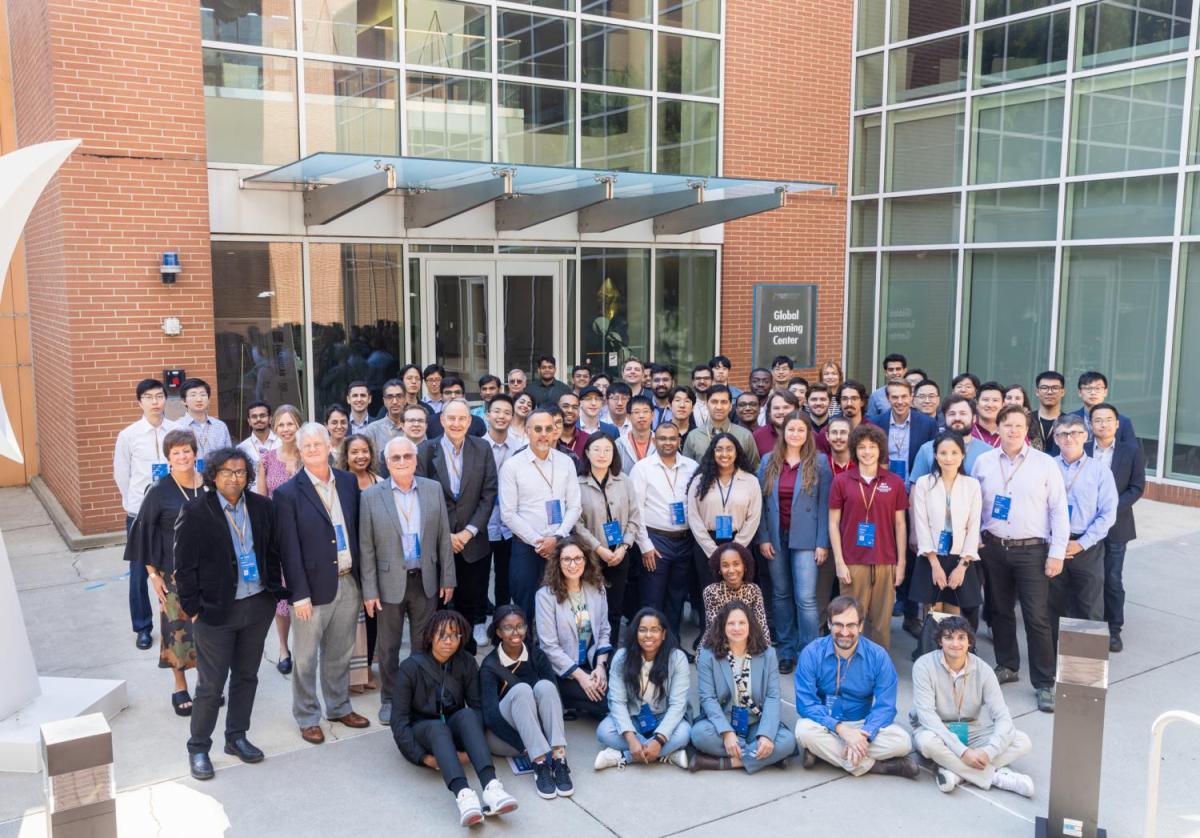
The Center on Cognitive Multispectral Sensors (CogniSense) held its second annual review earlier this month at the Georgia Tech Global Learning Center.
CogniSense is one of seven Joint University Microelectronics Program 2.0 (JUMP 2.0) academic research centers co-sponsored by the Semiconductor Research Corporation (SRC) and Defense Advanced Research Projects Agency (DARPA) and one of two JUMP 2.0 centers led by the Georgia Tech School of Electrical and Computer Engineering (ECE).
This year’s review highlighted the center’s progress in creating smarter, energy-efficient cognitive sensors for various applications, such as robotics and autonomous vehicles.
The event brought together leading experts from the 12 CogniSense partner universities to share accomplishments and insights, and connect with industry and government sponsors. The over 150 attendees included 120 researchers and students, as well as industry professionals from companies like TSMC, Intel, IBM, Samsung, Raytheon.
“We extend our thanks to all of our industry partners, principal investigators, and students for attending the CogniSense 2024 Annual Review,” said Georgia Tech Professor Saibal Mukhopadhyay, who is the co-director of CogniSense. “It is always a privilege to celebrate the groundbreaking achievements of our entire team. We are excited to see what the future holds as we continue to push the boundaries of sensor technology together.”
Additionally, area high schoolers took part in the annual review, including Harmoni Griffin (Booker T. Washington High School) and Amya Payne (Coretta Scott King Young Women’s Leadership Academy). Both students are currently conducting research in Georgia Tech labs through Project ENGAGES (Engaging New Generations at Georgia Tech through Engineering & Science), a high school science education program developed at Georgia Tech in partnership with minority-serving privates & public schools in the City of Atlanta.
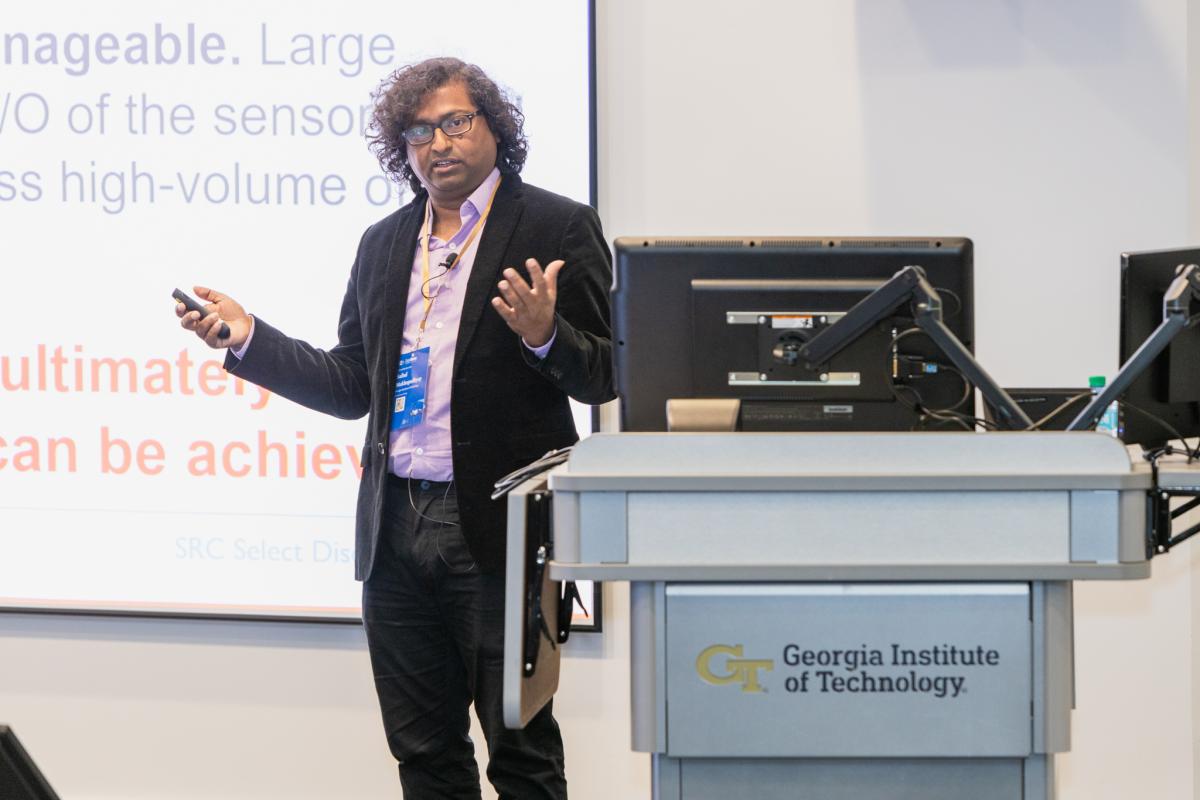
Georgia Tech Professor and co-director of CogniSense Saibal Mukhopadhyay.
During the review, presentations were delivered by Mukhopadhyay, as well as University of California Santa Barbara professor and CogniSense co-director Jim Buckwalter, and each principal investigator leading one of the five focus areas of CogniSense.
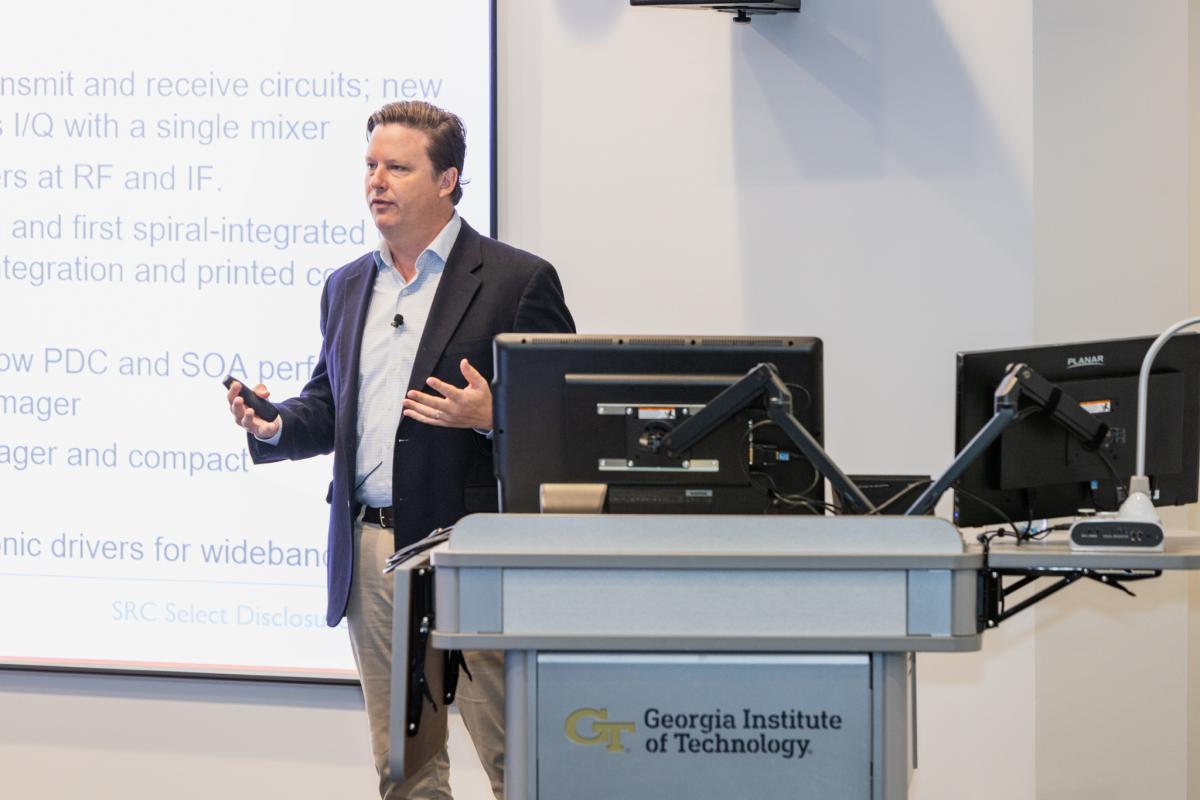
UC Santa Barbara Professor and co-director of CogniSense Jim Buckwalter.
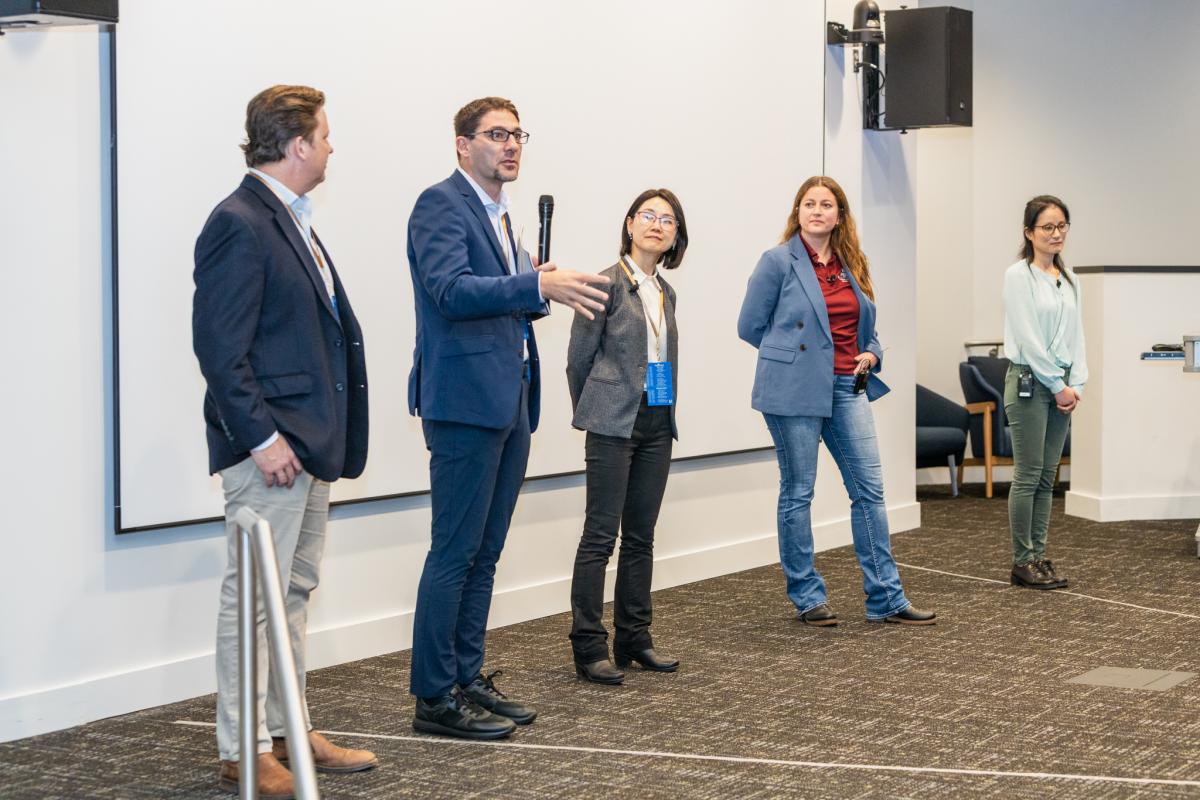
A portion of the principal investigators from CogniSense partner universities sharing insights during the annual review.
CogniSense Themes
Theme 1: Multi-spectral Array
- Advancing the capability of mm-wave MIMO radar, passive imaging, and lidar hardware. to achieve sensor convergence with adaptation for energy-efficient feature detection.
- Reduce power MIMO front-end hardware for sensing.
- Combine mm-wave radar, lidar, and passive sensing.
- Adopt hybrid analog/digital waveform techniques for power trade space.
- Adapt front-end circuitry power for task-specific dynamic range.
Theme 2: Analog-to-Insight
- Mixed-signal and digital feature extraction at the sensor to mitigate the data deluge.
- Pipeline combining computation and dimensionality reduction to dramatically reduce the data flow off the sensor.
- Adaptable feature extraction, integrated with Theme 3.
- Multi-layer analog feature extraction (AFE) followed by digital feature processing (DFP).
- Multi-modal features are fused at the digital output.
Theme 3: Closed-Loop Attention Control
- Add adaptivity to:
- Sensor fronts end
- Feature extract more informative insight while consuming less energy,
- Do so robustly across input and environmental conditions changes.
Theme 4: Heterogeneous System Integration
- Advance monolithic 3D and heterogeneous integration (3D/HI).
- System-wide thermal management and electro-thermal modeling.
- Develop power delivery from interposer to multiple voltage domains.
- Develop package-aware simulation platform for the 3D/HI sensor.
Theme 5: Sensor Programming and Collaborative Control
- Develop a collaborative framework at the host processor to improve sensing-to-action.
- A real-time controller running at the host controls the feature generation process to enable dynamic power/quality scaling of the sensing-to-action platform.
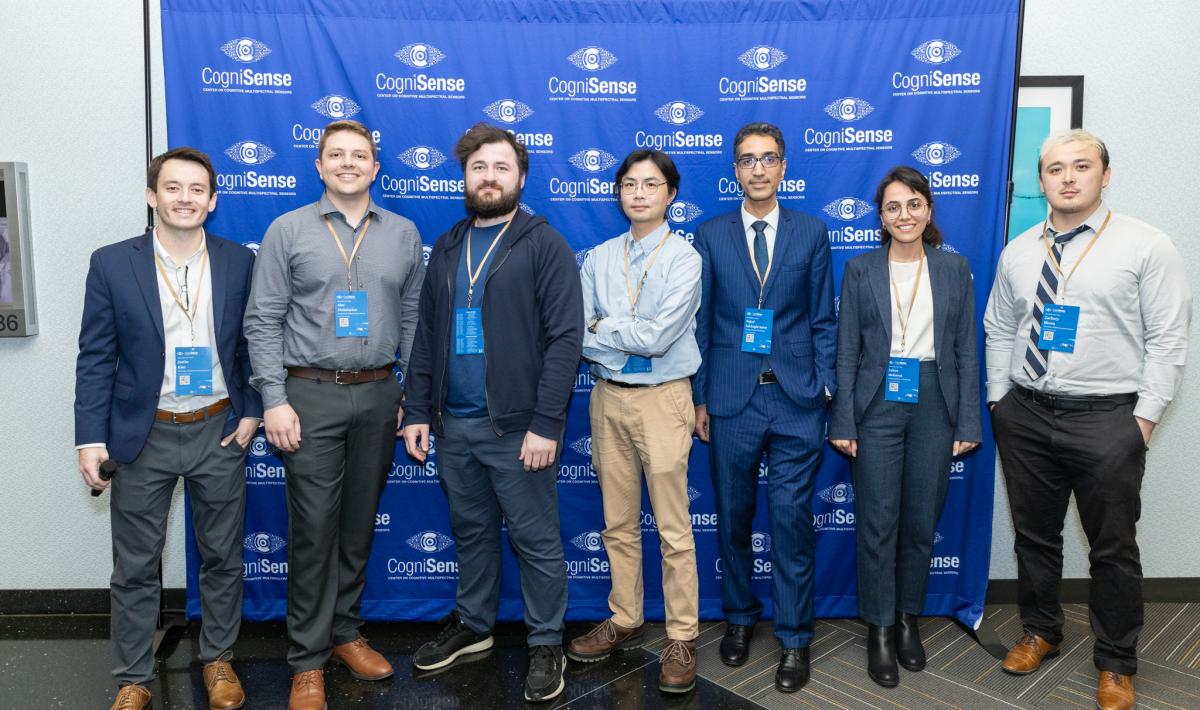
Student researchers at the CogniSense annual review.
Students participating in CogniSense research had an opportunity to present their research and participate in lightning talks during the review. Several ECE PhD students were recognized for their outstanding contributions with awards.
Presentation Winners
|
Name |
Award |
University |
|---|---|---|
|
Theme 1 Winners- Multi-Spectral Pixel Array |
||
| Alex Dinkelacker | 1st Place Lightning | University of California Santa Barbara |
| Daniel DeSantis Benjamin Mazur |
2nd Place Lightning | Massachusetts Institute of Technology |
| Justin Kim | 1st Place, Best Poster | University of California Santa Barbara |
| Alex Dinkelacker | 2nd Place, Best Poster | University of California Santa Barbara |
|
Name |
Award |
University |
|---|---|---|
|
Theme 2 Winners - Analog-to-Feature Extraction |
||
| Alex Saad-Falcon | 1st Place, Best Poster (TIE) | Georgia Institute of Technology |
| Zichan Fan | 1st Place, Best Poster (TIE) | University of Michigan |
| Jeong Taek Chang | 2nd Place, Best Poster | University of Michigan |
| Jeong Taek Chang | 1st Place, Lighting | University of Michigan |
| Zichan Fan | 2nd Place, Lighting | University of Michigan |
|
Name |
Award |
University |
|---|---|---|
|
Theme 3 Winners- Closed-loop-Attention |
||
| Chuan-Tung Lin | Ist Place, Lightning | Columbia University |
| Hashan Wre Rascoria | 2nd Place, Best Poster | University of California San Dieg |
| Jeong Taek Chang | 1st Place, Lighting | University of Michigan |
| Zichan Fan | 1st Place, Best Poster | University of Michigan |
|
Name |
Award |
University |
|---|---|---|
|
Theme 4 Winners- Heterogeneous System Integration |
||
| Danish Baig | 1st Place, Best Poster | Georgia Institute of Technology |
| Anahita Asadi Leonid Popryho |
2nd Place, Best Poster (TIE) | University of Illinois Chicago |
| Wanshu Zeng | 2nd Place, Best Poster (TIE) | Georgia Institute of Technology |
| Danish Baig | 1st Place, Lightning | Georgia Institute of Technology |
| Wanshu Zeng | 2nd Place, Lightning (TIE) | Georgia Institute of Technology |
| Anahita Asadi Leonid Popryho |
2nd Place, Lightning (TIE) | University of Illinois Chicago |
|
Name |
Award |
University |
|---|---|---|
|
Theme 5 Winners- System Software and Integration |
||
| Biswadeep Charaborty | Ist Place, Best Poster | Georgia Institute of Technology |
| Mir Sayeed Mohammad | 2nd Place, Best Poster | Georgia Institute of Technology |
| Biswadeep Charaborty | 1st Place, Lighting | Georgia Institute of Technology |
| Mir Sayeed Mohammad | 2nd Place, Lighting | University of Michigan |
(text and background only visible when logged in)
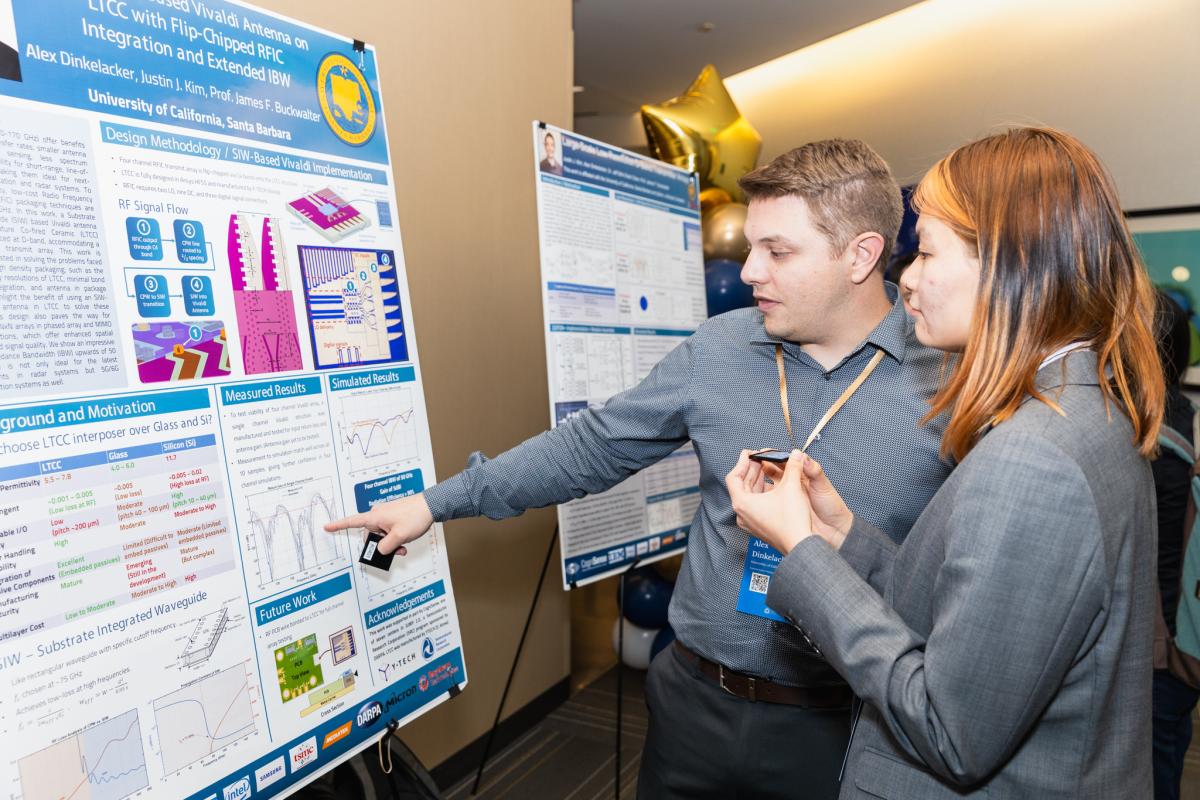
During the annual review students presented research conducted throughout the year.
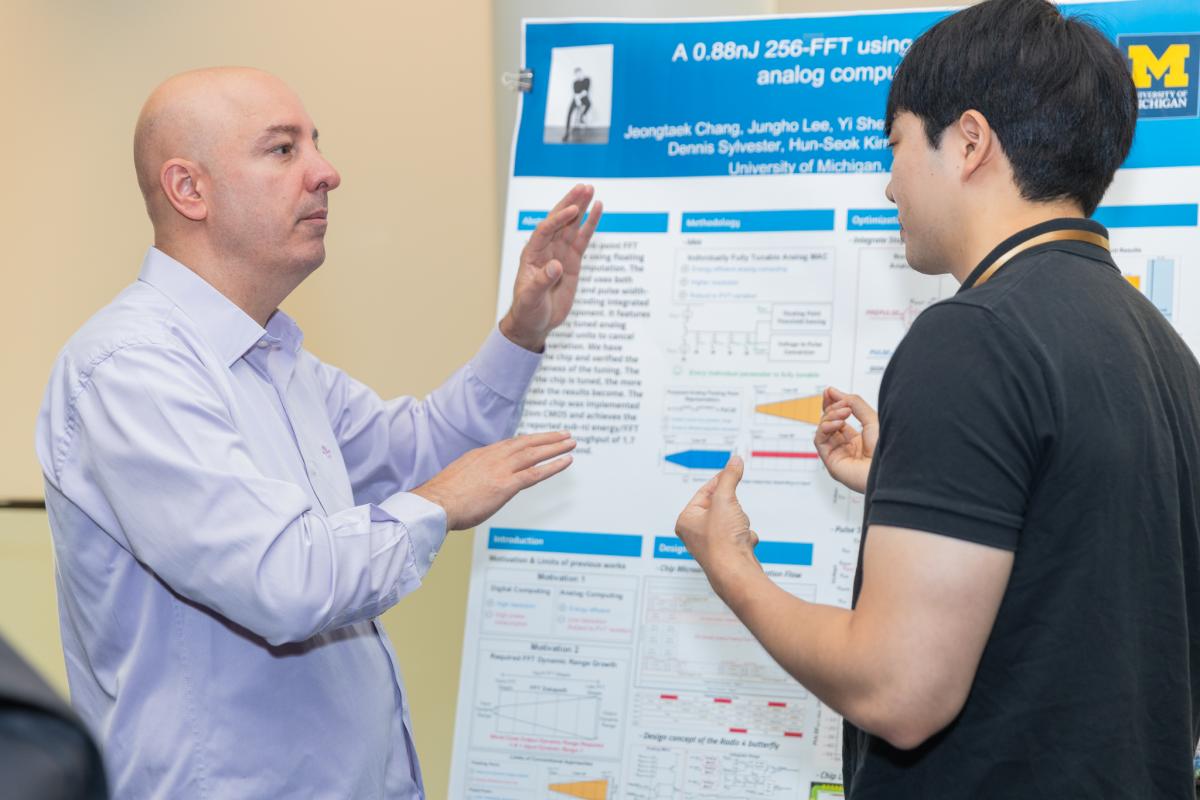
Research being presented at the second annual CogniSense review. Viewers got a look at the center's research and a preview of it's future goals over the course of the three-day event.
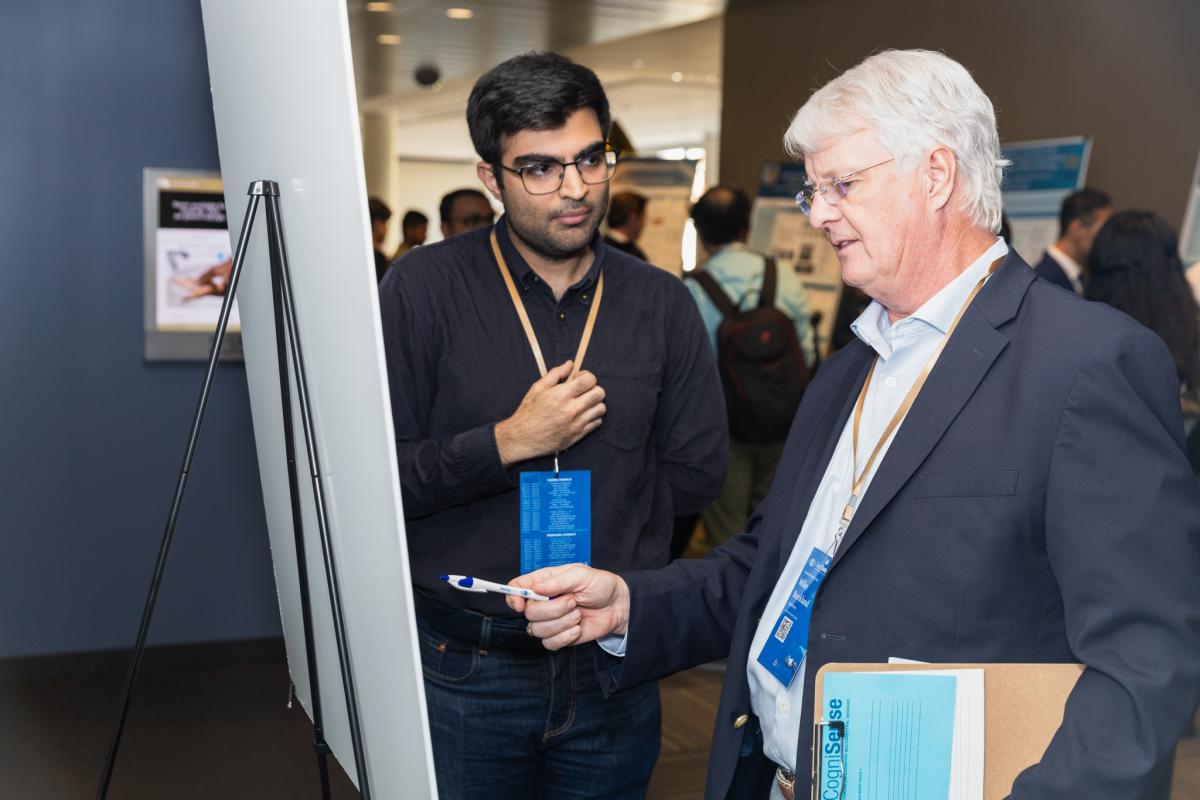
Judges reviews student presentations and research during the review.
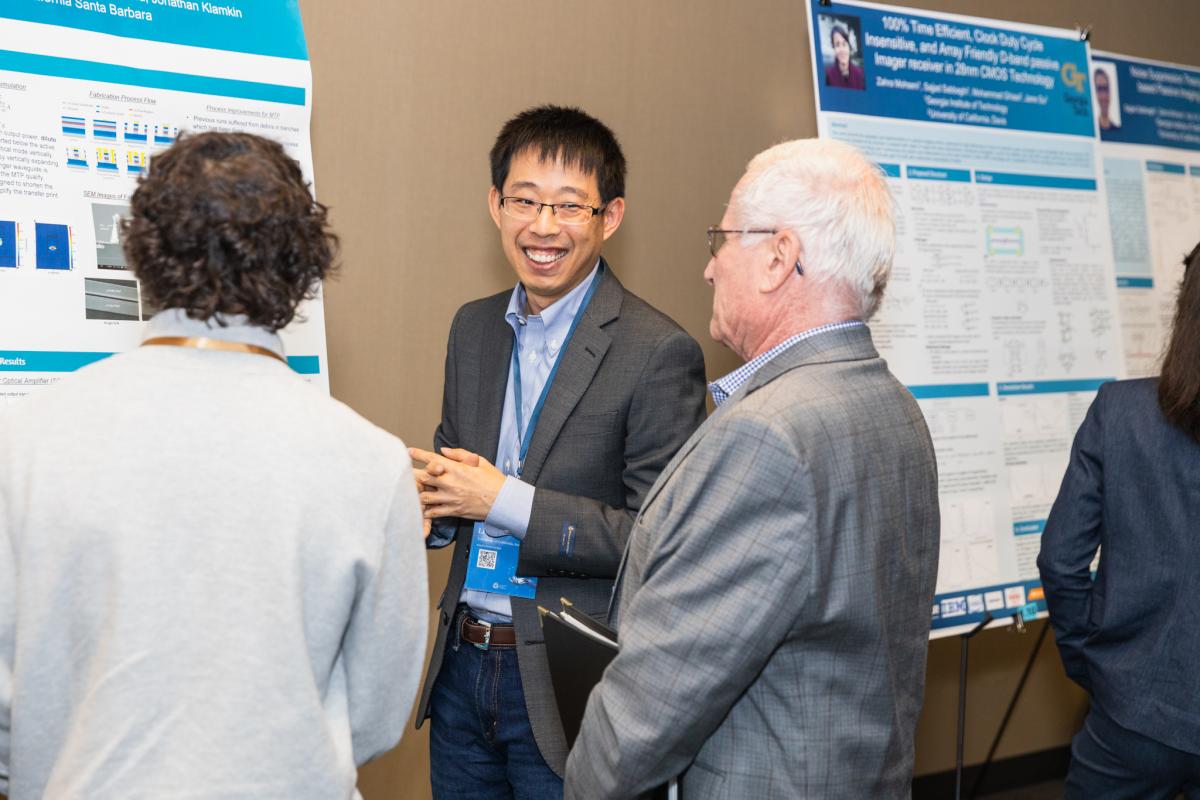
Students researchers look forward to presenting their research at the review.
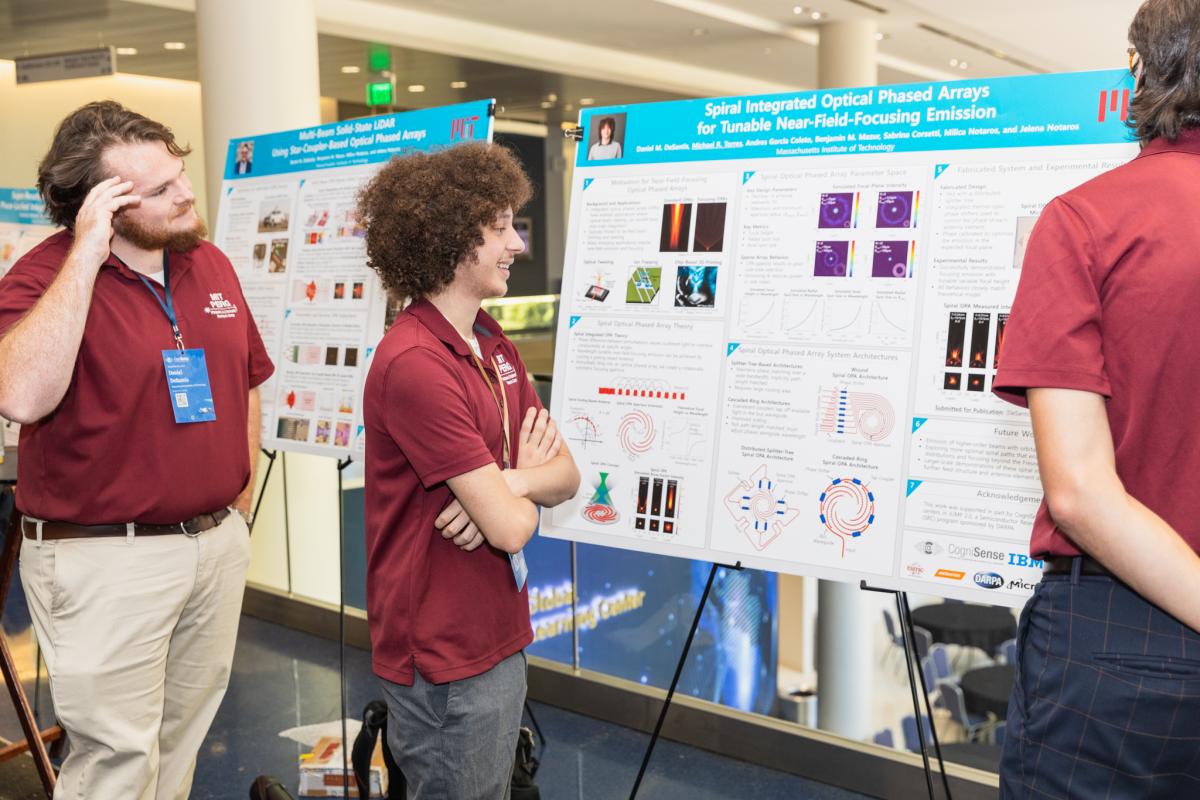
The MIT student research group presenting their research during day two of the review.
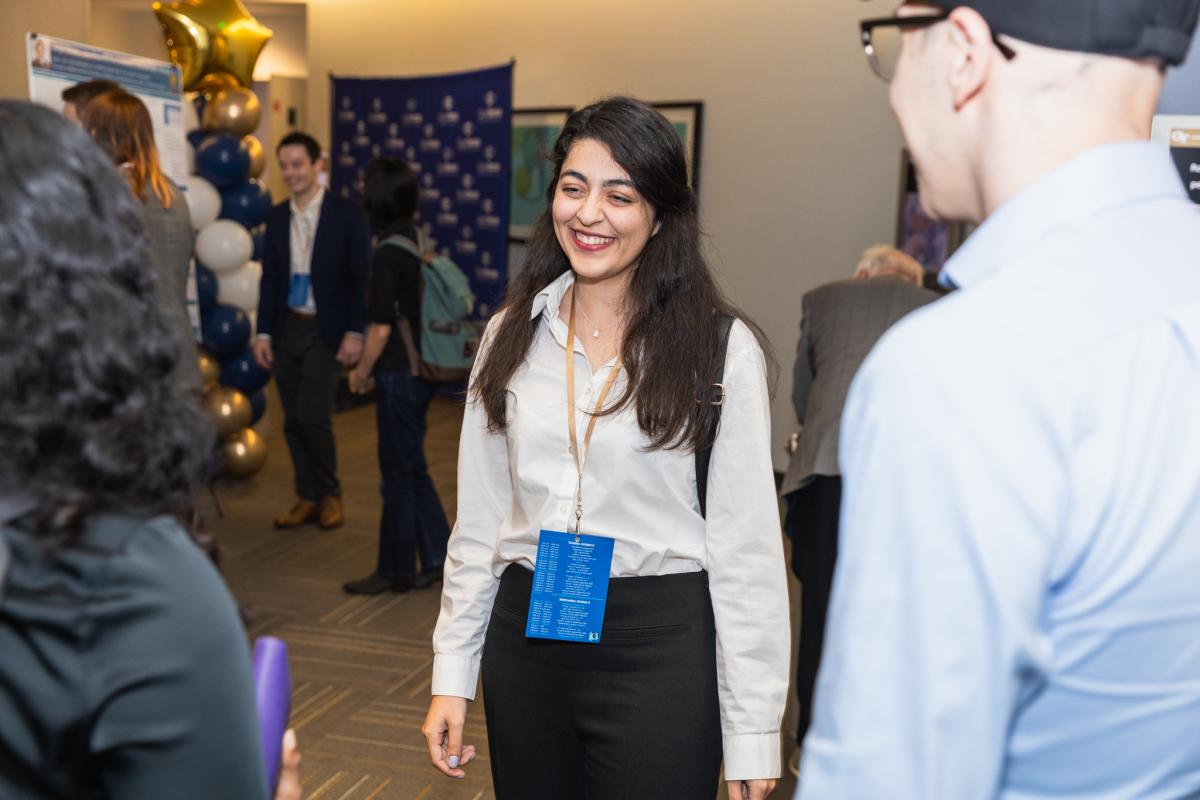
Students from across the 12 partner universities travelled for the three day annual review.
Other Notable Student Achievements:
- Sudarshan Sharma, Minah Lee, Weichun Wang for their work presented at the IEDM Conference, “A Current-Domain Compute-In-Memory
Macro for Analog-to-Feature Extraction.” - Jelena Notaros MIT Group’s paper on their chip tape-out slides was accepted to the JUMP’s Journal
- Best Paper Awards for the overall Center:
- Sudarshan Sharma , Minah Lee, Weichun Wang Best Publication Milestone Report IEDM Conference
- Coleman DeLude, IEEE Conference
- Jeff Chien, BCICTS Conference
“Student research is the driving force behind CogniSense,” Mukhopadhyay said. “We are immensely proud of our students’ accomplishments and look forward to celebrating many more important reviews in the years to come. Their innovative work not only advances our mission, but also fosters collaboration with industry partners, guiding our research towards impactful, real-world applications.”
In March, Georgia Tech’s other JUMP 2.0 center, the Center for the Co-Design of Cognitive Systems (CoCoSys), held its second annual review. Together, the two centers represent an investment of $65 million aimed to improve the nation’s technological performance, efficiency, and capabilities for both commercial and military applications.
(text and background only visible when logged in)
Related Content
Georgia Tech Receives $65 Million Grant from Semiconductor Research Corporation for JUMP 2.0 Centers
Two new research centers, representing an investment of about $65.7 million, have been awarded to Georgia Tech through the SRC-administrated Joint University Microelectronics Program 2.0, or JUMP 2.0.
CoCoSys Holds Second Annual Review
The event highlighted research projects conducted through the Center over the past year and previewed its upcoming goals.
